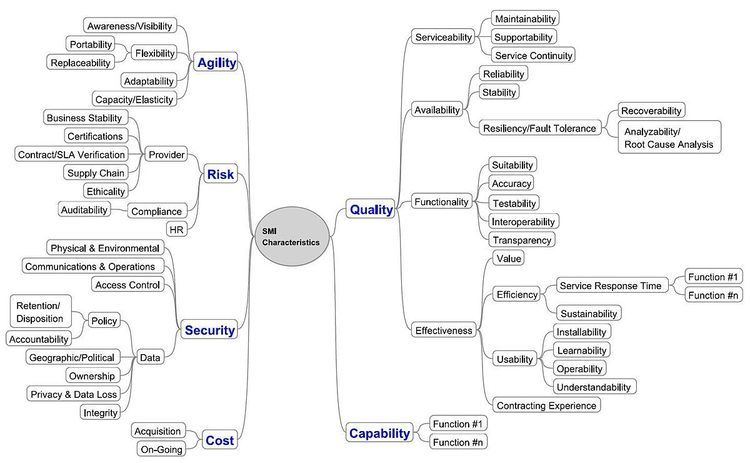 | ||
The Service Measurement Index is a framework designed to "measure the relative goodness of an IT Service".
Contents
Formal definition
The Service Measurement Index (SMI) defines a framework and method for the calculation of a relative index, which may be used to compare IT Services against one another, or to track services over time.
Function
From a practical standpoint, SMI enables consumers of IT business services to perform "apples-to-apples" comparisons so they can make informed decisions about selecting specific services and service providers. SMI works by letting consumers of cloud services rate them, via standardized surveys, across six key metrics: quality, agility, risk, cost, capability, and security. There is a large and growing database of completed surveys and currently over 120 services have been rated.
A consumer wishing to compare services can indicate how important each of the six metrics is to that user for a particular type of service. Comparison scores (1-99) are then generated from the ratings, relative to other services of the same type – taking into consideration the concerns of this consumer. For example, if a particular consumer wants to compare email services and for that consumer, Security is more important than Cost, the SMI will assign higher scores to email services where security is a stronger point than cost. The scores are thus customized to “your” concerns, even though the metrics are standardized.
Principles of operation
In order to determine the relative goodness of an IT Service, one must first understand:
In order to make a meaningful relative comparison of IT Services, only those services which are functionally similar can be included in any comparison. This implies that a standard taxonomy of IT Services must be used so that each separate user of the Service Management Index is not required to define the functions for which they are searching.
Such a standard taxonomy is currently being produced by the TM Forum project "Cloud Service Definitions (Taxonomy)", and can be viewed here.
The term "goodness" is used to express the appropriateness or usefulness of the IT Service to a specific consumer of that service. The service provider must, therefore, define the factors or characteristics which make up the composite called "goodness"; each consumer's individual weighting of those characteristics will tailor the composite to their specific needs.
The initial characteristics are organized in an hierarchical structure as follows:
Cloud Commons website
Additional information relating to SMI and CSMIC can be found on the Cloud Commons web site here. Cloud Commons is an independent community of IT professionals, analysts, technology providers, and industry experts. In addition to being the home for SMI, it is a place to find and contribute user experiences, best practices, cloud-related news, and discussions.
